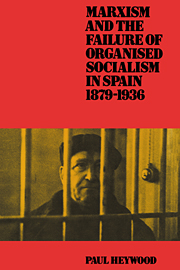Book contents
- Frontmatter
- Contents
- Preface
- Abbreviations used in text
- 1 Decaffeinated Marxists: the PSOE, 1879–1914
- 2 Reform, revolution and the roots of rupture: the PSOE, 1914–1919
- 3 Socialist schism and the development of organised Communism, 1919–1923
- 4 Dealing with a Dictator: organised Socialism, 1923–1931
- 5 Marxist mistakes: misinterpreting the Second Republic, 1931–1934
- 6 Marxism marginalised: the PSOE and the creation of the Popular Front, 1934–1936
- Conclusion
- Notes
- Bibliography
- Index
Preface
Published online by Cambridge University Press: 08 September 2009
- Frontmatter
- Contents
- Preface
- Abbreviations used in text
- 1 Decaffeinated Marxists: the PSOE, 1879–1914
- 2 Reform, revolution and the roots of rupture: the PSOE, 1914–1919
- 3 Socialist schism and the development of organised Communism, 1919–1923
- 4 Dealing with a Dictator: organised Socialism, 1923–1931
- 5 Marxist mistakes: misinterpreting the Second Republic, 1931–1934
- 6 Marxism marginalised: the PSOE and the creation of the Popular Front, 1934–1936
- Conclusion
- Notes
- Bibliography
- Index
Summary
This study sets out to examine the relationship between the theory and practice of a major European Socialist party, the Partido Socialista Obrero Español (PSOE), from its foundation in 1879 to the outbreak of the Spanish Civil War in 1936. During this period, the PSOE was, despite its slow growth, the largest working-class party in Spain, and for a crucial spell in the 1930s, the largest parliamentary party. Indeed, its political significance in both the creation and the collapse of the ill-fated Second Republic (1931–6) can hardly be overstated. As a result, published studies of the Spanish Socialist movement have understandably shown a marked tendency to concentrate on the PSOE's role during this five-year period. In particular, attention has been focussed on the divisions within the party which culminated in its notorious post–1933 ‘radicalisation’, often seen as central to the breakdown of political stability in the Second Republic. Moreover, the divisions which so damaged the PSOE during the Republic have been seen as all the more noteworthy in that they represent a marked contrast to its apparently traditional unity and discipline: although relatively small in terms of membership, the PSOE prior to 1931 had supposedly manifested an organisational cohesion unique amongst the political groups opposed to the Restoration Monarchy (1875–1931). Remarkably, for all the PSOE's significance, there still exists no comprehensive study of the Spanish Socialist Party from its formation to the Civil War. This book aims to serve as a contribution to filling that gap.
Nonetheless, the main focus of the book – the relationship between theory and practice in the Spanish Socialist movement – may at first sight appear somewhat curious.
- Type
- Chapter
- Information
- Publisher: Cambridge University PressPrint publication year: 1990

